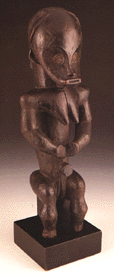
Fang-Ntumu,
female Byeri statuette, Gabon | Tribal art is a much tricky field for collectors who have to take into account that it was always linked with the life of African or Oceanic tribes.
Statues, masks and totems all have a story because they were in constant use in tribal ceremonies. Until the end of the 19th century, tribal art was practically unknown to foreigners. It was only after a series of missions led by explorers in Africa that these strange objects started to be collected. Strangely enough, the first collectors at the turn of the century were modern artists such as Picasso, |
Derain, Vlaminck or Matisse who found vivid inspiration in the forms of these dramatically appealing objects.
The Musée d'Aquitaine in Bordeaux has been showing until May 3rd 1998 a remarkable selection of works from Gabon, masks, statues, reliquaries and objects, notably a Fang reliquary mask bought in 1902 from a missionary who found it in Northern Gabon. It is now the property of the Ethnographic Museum of Neuchâtel, Switzerland. The exhibition has been an opportunity to show how Gabon tribes lived through their rites and for what purposes these pieces were made. These tribes dwelled essentially in forests alongside rivers, they were divided in many ethnic groups, notably the Fang in the North, the Kota in the East and the Punu in the South. All had similar ways of life organisation with chiefs and magistrates which were dismantled after the colonisation. These men were hunters and farmers and used to make elaborate artefacts and had an intense spiritual life underlined by constant ceremonies. As a result, these tribes cultivated the sacred to a great extent and produced masks in numbers.
Used in ceremonies these masks were meant to protect them from death or evil. On a Fang mask, white is the colour of death while the Kota Emboli masks were worn to initiate young boys. Other masks, of Cubist design, were destined to secret societies. Statues were carved to honour ancestors in these tribes where parental links were extremely strong.
The need for talented sculptors was essential. All the more these were often masters of ceremonies and venerated for their skills.
Fang reliquaries were used for the Byeri cult and in ceremonies, statues were placed on a receptacle containing the remains of an ancestor and coated with oil or blood from an animal. Each tribe adopted a particular style of carving and took great care of their masks and statues which are now considered as art masterpieces by many collectors around the world.Another important fact is that a mask or statue should have had a ceremonial use. There are some old types which seem more spectacular in style but are ignored by collectors because these were never worn contrary to others, made less than 50 years ago, which were used in ceremonies.
Tourism which started to bloom after the 1960's in Africa was omen for local artists who produced many objects sold as souvenirs. Thousands of statues and masks produced during the last 20 years have flooded the art market but remain worthless.